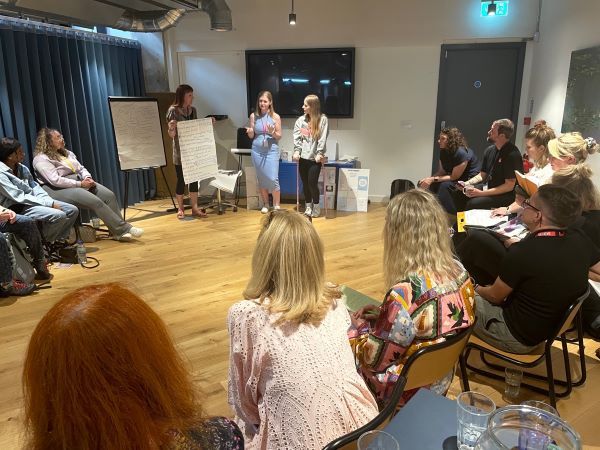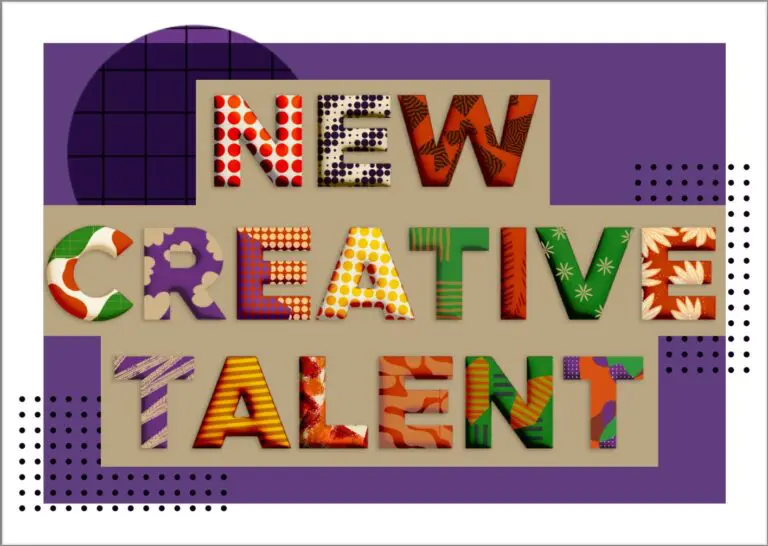
This blog is part of a series of resources behind the GCA’s New Creative Talent initiative, which aims to support members looking to recruit new talent, as well as to raise the profile of the greeting card industry with Universities and Colleges, and attracting post graduates into our sector.
Introduction
In this article Geoff Sanderson, who has spent many years recruiting and developing greeting card designers in businesses such as Tigerprint/M&S, Hallmark, Moonpig and now runs his own talent spotting and mentoring agency; shares his insights and tips along with Eve Gray, Creative
Development Director Future Squad at Hallmark, who manages their graduate programme.
This comprehensive guide covers all areas of working with Universities and Graduates.

Development Director Future Squad Hallmark,

Why work with graduates?
The industry and most likely your business will require a constant pipeline of new design, whether brand new creations from scratch or re formatted from previous best sellers, archives, or back catalogue. Which all aims to ensure the variety and differentiation of each publisher, retailer and range as well as ensuring relevance and adapting to the changing consumer behaviour and design trends over time.
The development and management of product ranges also requires a wide selection of design disciples, experience, and knowledge to create the desired mix whether experienced professionals or new up and coming talent. This could be in the form of in-house teams, contractors or freelancers as budgets, costs and scale dictates.
Hence, your creative talent pool needs to be wide and varied. For every illustrator creating a new page 1, there’s a graphic designer creating page 4’s branding, packaging, catalogues and print; web designers building e-commerce shops and apps; content creators making social media posts and writers, photographers and design managers linking it all together.
In short, it makes good sense to ensure that graduates form part of this flow in your range planning as not only can they play a creative part in making relevant and innovative design but also allow the tiering of studio salaries and roles, freelance fees and structuring of budgets to suit the need.
Engaging new design talent
So, how and where do you start with the process of engaging with new design talent?
The truth is, sadly many graduates and aspiring creatives don’t know the greeting card industry exists in the same way that we do, so in my eyes the emphasis is not just on the graduates to track us down but for us to find them.
There are no hard and fast rules to this process. I’ve seen many ways and models over the years, and everyone is free to do as they wish. But as an industry it makes sense, through the GCA, if we start to work towards some common messaging and credible standards – for publishers, creatives, and academia alike.
Geoff Sanderson
Geoff and Eve have put this comprehensive guide together on working with undergraduates and setting projects with universities.
Establishing a graduate project or placement strategy
- Establish and agree a WHAT + WHY + HOW for Placements/Internships and University/College Projects
- Each can bring a different benefit, outcome, and results
- Work out the mutual benefit (business and undergraduate/graduate)
- Do you have time to dedicate to setting a brief with a college or working alongside a graduate i.e., mentoring and developing. Often doing the project as a team works best – divide and conquer!
- Set a realistic timeframe so the precess is not stressful for you and the business as well as fits the academic calendar.
- How, when and on what financial basis do you want to offer work?
- When you have a plan get your team and business on board and involved. The pay back can often be as much in team building and your staff learning soft management skills in nurturing and “putting something back” as much as the ideas and work generated.
Setting College Projects and visiting Degrees Shows
- This may be a brief or project you set with undergraduates during term time with your local Uni, which makes it easy for you to manage or if you are happy work online for example via Teams this can broaden your reach.
- It’s important to make your brief relevant to the course and fit specific learning outcomes (that the course leaders can assist in shaping – as well as engaging the undergraduate and meeting your own needs)
- You may wish to attend to set the brief or do a talk online to set some background. You can visit to judge outcomes or have them sent to you and you feed back?
- Do you have contacts at your local university? If not, a good start is to attend your local degree shows and meet the students and lecturers to build your own network
- You may even simply visit just to spot talent – which if you wanted to develop could be an offer of freelance work.
- Nationally there’s also the annual creative graduate New Designer and New Blood showcases in London (see links below)
- Once relationships have been built with academics/universities, understand the role of industry collaboration within courses/modules and this will support how a brief can be written and subsequently interpreted by staff and undergraduates and its relevant for your needs.
- Academic years are planned in such a way that you need to be aware of when semesters require industry collaboration, and this will dictate when the brief occurs
- Allow time to brief, provide interim feedback and final critique of projects. Interim critique yields the best results
- Unless work is purchased, all work completed belongs to undergraduates and all rights remain with them.
Considering Placements and Internships
- Placements or internships generally happen post-graduation or during term holidays
- Placements are generally a shorter duration (possibly from 2-3 days to 2-3 weeks) and are about a specific set project with a beginning, middle and an end.
- Internships are generally over a longer time (4 weeks and upwards), possibly with a view to recruitment. In a sense, a trial in a role with mentoring and a chance for the graduate to work across your business
- If a placement goes well it could lead to an internship
- For all options we’d recommend you pay at least a living wage. An unpaid placement is not ethical and can affect the reputation of the business (and GCA if associated)
- Develop a Welcome Pack (Virtual / IRL / Hybrid)
- Overview of value of the placement/internship to the business
- Information about the business (overview)
- Names / details of key contacts during placement/internship
- NDA (to sign + return)
- GDPR Privacy Notice (for information)
- Any relevant internal policies as appropriate: EG: Technology Policy
- Safe Systems at Work – any relevant training: scalpel use / digital standards
- Health & Safety Policy
The process of organising
- If the placement is a result of University/College Projects, seek permission to obtain email details of intern/placement from academic tutor (GDPR compliance)
- If the placement is a result of New Designers or degree show, request details
- Email intern/placement and request written permission to keep email details for duration of placement and share with any team member who may be involved for the duration of the placement (GDPR compliance)
- Keep written permission in ‘safe’ location (GDPR compliance)
- Organise dates and working pattern (IRL, Virtual, Hybrid)
- Send Intern/Placement Written Confirmation of Placement Letter (dates/pay)
- Communication about placement expectations
- Send Welcome Pack prior to internship/placement
- Request signed forms to be returned for records
- Organise internal access and training required
- If hybrid working, establish suitable communication methodology
- Make sure a rate is negotiated (hourly/daily) and set up as an External Asset supplier.
- Contracts issued and completed prior to any work commencing.
- Recent graduates may require a little more nurture as this may be their first project
- Graduates are increasingly aware of their own IP and can be reluctant to comply with contractual requests and may seek a license agreement, especially if they have a very distinctive visual language.
- This is of course a two-way understanding. To avoid a miss understanding an explanation about your own IP i.e., designs, content, brand e.t.c. maybe required as they could be working with it.
- In short, a conversation to explain how you need them to help you respect and protect your IP i.e. not show on social media without approval, as well as how you will treat, respecting and valuing theirs, will help with context.
Placement Tips
There are many ways to organise a placement
- Locationally – it may be all in-house, a hybrid mix or all external and online
- Duration – you may wish to have someone working 8 hours a day, 5 days a week or a more flexible arrangement as the brief and graduate’s time allows. NB Most recent graduates are also working part-time to pay back their loans and rent and may have other placement or plans post-graduation. It’s good to check this in advance too
- Briefing + Feedback – briefs should have enough leeway for flexibility and discussion enabling placement/intern to bring new perspectives and thoughts
- Clarify expectations and attendance approach
- Nurture – emotional intelligence and empathy are needed here. It does take time to work appropriately with placement/intern to achieve successful results. Success is dictated by answering the question why you wish to participate in this kind of connection/collaboration
- Undertake any appropriate training if required
- Develop file sharing methodology for digital submission and potential feedback
- Organise final presentation and leave appropriate time to upload files
- Request feedback from placement/intern
Call to Action for members
We know a lot of good work is happening in the industry generally in this space, whether work placements and recruitment, new ranges being launched or sponsorship and Uni/retailer tie-ins. It’d be great to showcase and feature your good work too and hear your stories so we can promote and share experiences.
If you’d like any further help and advice less feel free to contact us or feel get in
touch with Geoff directly geoffsanderson@mac.com
Help for university and college course leaders
Tracy Allanson-Smith, Visual Communication Employability Coordinator at Birmingham Institute of Creative Arts, has kindly written a blog, sharing her experience and thoughts on the greeting card Industry and the opportunity for universities and college lecturers and their students.
In Connecting Students with the Greetings Card Industry Tracy shares her experience and top tips for connecting students with the greeting card industry.
Help for Students looking to work in the greeting card industry
See Geoff’s blog, Graduate Opportunities in the Greeting Card Industry for useful links and information
Further Information and resources
If you’re a GCA member keen to know more, or a student keen to learn more, read How to Get into the Greeting Card Industry . A project when we teamed up with the Illustration & Graphic Design team at the School of Creative Arts University of Hertfordshire. This includes a useful handout for schools and colleges which can be downloaded.
For GCA members wishing to visit their local school, college or University there is a presentation and toolkit in the members’ library that you can use – adding in your own slides to promote your brand.
If you are a University or Collage wishing to learn more see Connecting Students with the Greeting Card Industry
GCA members can advertise vacancies for free on our website https://www.gca.cards/jobs/
The GCA New Creative Talent project was launched in 2022, see the Secret to Creative Innovation and Succession Planning for more information, and these links to see more about GCA Open Call 2022
For latest greeting card industry news and events see our blogs
To receive our monthly newsletter Sign up for our newsletter here
If you’re interesting in Becoming a Greeting Card Artist see this blog, with lots more tips and information in our members library.
If you’re interested in Working with an Artist’s Agent, see this blog.
For further reading Geoff and Eve have shared links from quoted sources below.
- Arts and Creative Industries: The case for a strategy https://lordslibrary.parliament.uk/arts-and-creative-industries-the-case-for-a-strategy/
- Overview of the UK’s Creative Arts sector https://www.prospects.ac.uk/jobs-and-work-experience/job-sectors/creative-arts-and-design/overview-of-the-uks-creative-arts-sector
- Number of Art and Design students on the rise in the UK https://www.designweek.co.uk/issues/10-16-august/number-of-art-and-design-students-on-the-rise-in-the-uk/
- Fact Sheet. Study Art and Design in the UK https://study-uk.britishcouncil.org/plan-studies/choosing-course/subjects/art-design
- New Designers https://www.newdesigners.com
- D&AD New Blood https://www.dandad.org/en/d-ad-new-blood-awards/
- How to build better working environments for new creatives https://www.creativereview.co.uk/creative-placements-advice/
If you’d like to share your stories, provide any help, advice, or feedback, require more specific information or any advice we’d love to hear from you contact us.
Further updates on the Open Call for 2023-2024 to follow soon.





